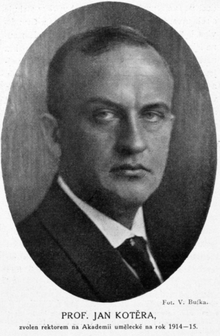Jan Kotěra
| Jan Kotěra | |
|---|---|
 1923 portrait by Vladimír Jindřich Bufka | |
| Born |
18 December 1871 Brno, Margraviate of Moravia |
| Died |
17 April 1923 (aged 51) Prague, Czechoslovakia |
| Residence | Trmalova Villa |
| Nationality | Czech |
| Known for | Architecture |
Jan Kotěra (18 December 1871 – 17 April 1923) was a Czech architect, artist and interior designer, and one of the key figures of modern architecture in Bohemia.
Biography
Kotěra was born in Brno, the largest city in Moravia, to a Czech father and German-speaking mother. He studied architecture in Vienna during the waning days of the Austro-Hungarian Empire under the Viennese master Otto Wagner.[1]
Kotěra returned to Prague in 1897 to help found a dynamic movement of Czech nationalist artists and architects centered on the Mánes Union of Fine Arts. Strongly influenced by the work of the Vienna Secession, his work bridged late nineteenth-century architectural design and early modernism. Kotěra collaborated with Czech sculptors Jan Štursa, Stanislav Sucharda, and Stanislav's son Vojtěch Sucharda on a number of buildings.
As a teacher, Kotěra trained a generation of Czech architects, including Josef Gočár, who would bring Czech modernism to its pinnacle in the years leading up to the Nazi occupation in 1939. Kotěra was one of a number of Czech architects to design the "Bata houses" and Bata shoe factory at East Tilbury, Essex, England.[2]
Works
- Museum of Eastern Bohemia in Hradec Králové,[3] (1908–1912)
- Peterka House, 12 Wenceslas Square, Prague (1899–1900)
- National House in Prostějov
- Trmalova Villa - an early rustic villa in Prague[4]
- Villa of Tomáš Baťa in Zlín
- Faculty of Law at Charles University in Prague (1924–1927)
- Two monuments for members of the Perutz family at the New Jewish Cemetery
Gallery
 Museum of Eastern Bohemia, Hradec Králové.
Museum of Eastern Bohemia, Hradec Králové. Národní dům (National House), Prostějov.
Národní dům (National House), Prostějov.- Baťa's villa, Zlín.
 Faculty of Law, Prague.
Faculty of Law, Prague.- Bust in Prague.
References
- ↑ Pevsner, Nikolaus, Sir James Maude Richards & Dennis Sharp (2000). The anti-rationalists and the rationalists, Architectural Press, p. 106. ISBN 0-7506-4815-5
- ↑ Rose, Steve (2006-06-19). "Steve Rose: on East Tilbury the most Modern town in Britain". The Guardian. ISSN 0261-3077. Retrieved 2017-11-20.
- ↑ Jan Kotěra, 1871-1923:the founder of modern Czech architecture. Municipal House. 2001.
- ↑ Cultural Movement, Foibos.cz, retrieved 4 November 2013
External links
| Wikimedia Commons has media related to Jan Kotěra. |
- Works by or about Jan Kotěra at Internet Archive
- Pictures from Hradec Králové museum
- List of works (in Czech)
- summary biography with images a